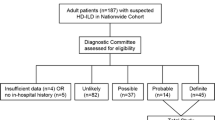Abstract
Objectives
To report radiologic findings with histopathologic correlations of humidifier disinfectant-associated children’s interstitial lung disease (HD-chILD) and to compare computed tomography (CT) findings between survivors and non-survivors.
Methods
Forty-seven children with HD-chILD (27.4 ± 12.4 months old) were categorized as survivors (n = 25) and non-survivors (n = 22). The patterns, distributions, and chronological changes in lung lesions at follow-up CT were investigated. Histopathologic correlations were performed in 23 patients.
Results
CT features were characterized by chronological changes, from consolidation to centrilobular opacities, and lesions eventually became faint centrilobular nodules. Histopathologic features were bronchocentric-distributed fibro-inflammatory lesions, which were more profound in the advanced stage than the early stage. Consolidation ≥30 % [hazard ratio (HR), 2.932], centrilobular opacities ≥60 % of the total lung volume (TLV; HR, 0.206) and spontaneous air leaks (HR, 3.457) were significant factors associated with patient survival, as per univariate analysis. Consolidation ≥30 % (HR, 3.519), centrilobular opacities ≥60 % (HR, 0.205) and diffuse ground glass opacity (GGO) ≥70 % of the TLV (HR, 3.521) were significant factors associated with patient survival, as determined via multivariate analysis.
Conclusion
Distinctive chronological CT features were observed in the HD-chILD images. Spontaneous air leaks, consolidation, GGO, and centrilobular opacities were prognostic factors.
Key Points
• Chemical disinfectants can induce severe inhalation lung injury
• Lung injury caused by inhaled disinfectants demonstrates chronologic changes in radiologic findings
• Understanding of radiological characteristics is important to predict outcomes in chemical pneumonitis
• Physicians should be aware of the potential risk of environmental chemicals





Similar content being viewed by others
Abbreviations
- HD-chILD:
-
Humidifier disinfectant-associated children’s interstitial lung disease
References
Cheon CK, Jin H-S, Kang EK, Kim HB, Kim B-J, Yu J et al (2008) Epidemic acute interstitial pneumonia in children occurred during the early 2006s. Korean J Pediatr 51:383
Kim B-J, Kim HA, Song Y-H, Yu J, Kim S, Park SJ et al (2009) Nationwide surveillance of acute interstitial pneumonia in Korea. Korean J Pediatr 52:324
Lee E, Seo JH, Kim HY, Yu J, Jhang WK, Park SJ et al (2013) Toxic inhalational injury-associated interstitial lung disease in children. J Korean Med Sci 28:915–923
Lee JH, Kim YH, Kwon JH (2012) Fatal misuse of humidifier disinfectants in Korea: importance of screening risk assessment and implications for management of chemicals in consumer products. Environ Sci Technol 46:2498–2500
Lee E, Seo JH, Kim HY, Yu J, Song JW, Park YS et al (2012) Two series of familial cases with unclassified interstitial pneumonia with fibrosis. Allergy Asthma Immunol Res 4:240–244
Hong SB, Kim HJ, Huh JW, Do KH, Jang SJ, Song JS et al (2014) A cluster of lung injury associated with home humidifier use: clinical, radiological and pathological description of a new syndrome. Thorax 69:694–702
Yang HJ, Kim HJ, Yu J, Lee E, Jung YH, Kim HY et al (2013) Inhalation toxicity of humidifier disinfectants as a risk factor of children's interstitial lung disease in Korea: a case-control study. PLoS One 8, e64430
Kim KW, Ahn K, Yang HJ, Lee S, Park JD, Kim WK et al (2014) Humidifier disinfectant-associated children's interstitial lung disease. Am J Respir Crit Care Med 189:48–56
Kim HJ, Lee MS, Hong SB, Huh JW, Do KH, Jang SJ et al (2014) A cluster of lung injury cases associated with home humidifier use: an epidemiological investigation. Thorax 69:703–708
Hansell DM, Bankier AA, MacMahon H, McLoud TC, Muller NL, Remy J (2008) Fleischner Society: glossary of terms for thoracic imaging. Radiology 246:697–722
Lester SC (2006) Manual of surgical pathology, 2nd edn. Elsevier Churchill Livingstones, New York, NY
Ichikado K, Suga M, Gushima Y, Johkoh T, Iyonaga K, Yokoyama T et al (2000) Hyperoxia-induced diffuse alveolar damage in pigs: correlation between thin-section CT and histopathologic findings. Radiology 216:531–538
Gattinoni L, Caironi P, Pelosi P, Goodman LR (2001) What has computed tomography taught us about the acute respiratory distress syndrome? Am J Respir Crit Care Med 164:1701–1711
Ichikado K, Suga M, Muller NL, Taniguchi H, Kondoh Y, Akira M et al (2002) Acute interstitial pneumonia: comparison of high-resolution computed tomography findings between survivors and nonsurvivors. Am J Respir Crit Care Med 165:1551–1556
Selman M, Pardo A, King TE Jr (2012) Hypersensitivity pneumonitis: insights in diagnosis and pathobiology. Am J Respir Crit Care Med 186:314–324
Primack SL, Hartman TE, Ikezoe J, Akira M, Sakatani M, Muller NL (1993) Acute interstitial pneumonia: radiographic and CT findings in nine patients. Radiology 188:817–820
Acknowledgments
The scientific guarantor of this publication is Jin Seong Lee.
The authors of this manuscript declare no relationships with any companies, whose products or services may be related to the subject matter of the article. This study has received funding by the National Institute of Environment Research (2014-0677) and the Korea Environmental Industry & Technology Institute (2014-0784), Republic of Korea. One of the authors (Seon-Ok Kim) has significant statistical expertise. Institutional Review Board approval was obtained. Written informed consent was waived by the Institutional Review Board. Some study subjects have been previously reported in the Journal of Korean medical science by Lee et al. [3], in PloS One by Yang et al. [7] and in the American Journal of Respiratory and Critical Care Medicine by Kim et al. [8].
Methodology: retrospective, observational, performed at one institution.
Author information
Authors and Affiliations
Corresponding author
Appendix
Appendix
Rights and permissions
About this article
Cite this article
Yoon, H.M., Lee, E., Lee, J.S. et al. Humidifier disinfectant-associated children’s interstitial lung disease: Computed tomographic features, histopathologic correlation and comparison between survivors and non-survivors. Eur Radiol 26, 235–243 (2016). https://doi.org/10.1007/s00330-015-3813-1
Received:
Revised:
Accepted:
Published:
Issue Date:
DOI: https://doi.org/10.1007/s00330-015-3813-1




